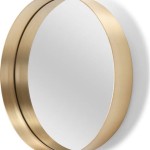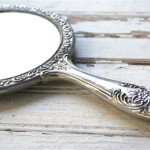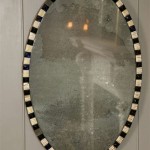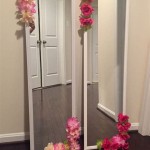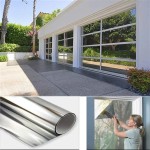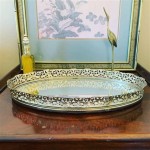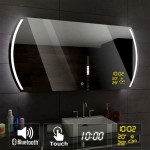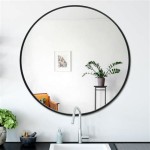How To Frame a Mirror Without Taking It Off the Wall
Framing a mirror already mounted on a wall presents unique challenges but can be accomplished with careful planning and execution. This method avoids the complexities of removing, potentially damaging, and remounting a heavy mirror. This guide outlines the necessary steps and considerations for a successful framing project.
Assessment and Material Selection: Begin by accurately measuring the mirror's dimensions. Precise measurements are crucial for a well-fitted frame. Consider the mirror's existing style and the surrounding décor when selecting frame materials. Common options include wood, metal, or composite materials. The frame's width and depth should be proportional to the mirror's size, creating a visually balanced aesthetic. Consider the wall's material, as this will influence the type of fasteners required.
Frame Construction: While pre-made frames are available, constructing a custom frame offers greater design flexibility. Cut the chosen frame material to the measured dimensions, ensuring 45-degree angles for clean mitered corners. Wood frames can be joined using wood glue and reinforced with small nails or brads. Metal frames may require specialized joining techniques, such as soldering or mechanical fasteners. Composite frames often utilize interlocking mechanisms. Test fit the frame pieces around the mirror before permanently joining them to confirm accurate measurements and proper alignment.
Preparing the Mirror and Wall: Clean the mirror's surface thoroughly to ensure proper adhesion of any necessary mounting materials. Likewise, clean the wall area around the mirror's perimeter. Dust and debris can interfere with adhesive bonding or create an uneven surface for the frame. Protecting the mirror surface with masking tape during the framing process is advisable.
Attaching the Frame: Several methods exist for attaching the frame to the wall and around the mirror. One option involves using construction adhesive formulated for mirrors. Apply the adhesive to the back of the frame pieces, ensuring even coverage. Carefully position the frame sections around the mirror's edge, pressing firmly against both the mirror and the wall. Use painter's tape to secure the frame in place while the adhesive cures. Follow the adhesive manufacturer's instructions regarding curing time.
Alternative Mounting Methods: For heavier frames or situations requiring greater stability, consider using small L-brackets or Z-clips. L-brackets can be attached to the back of the frame and then secured to the wall using appropriate fasteners. Z-clips involve one part attached to the frame and a corresponding part attached to the wall. These methods offer a more robust attachment and can be beneficial for larger or heavier frames. Ensure fasteners are appropriate for the wall's material to prevent damage.
Finishing Touches: Once the frame is securely attached, remove any masking tape protecting the mirror. Inspect the frame for gaps or inconsistencies. Small gaps can be filled with wood filler or paintable caulk, depending on the frame material. After the filler dries, lightly sand the area smooth. Apply paint or stain to the frame as desired, complementing the surrounding décor. Consider applying a sealant to protect the frame from moisture and wear.
Working with Irregularly Shaped Mirrors: Framing an irregularly shaped mirror on the wall requires additional planning and adaptation. Flexible molding can be used to conform to curved or non-linear edges. Cut the molding to size and carefully apply it around the mirror's perimeter using an appropriate adhesive. Alternatively, creating a frame from smaller, individually cut pieces of material allows for a more customized fit to complex shapes. Take precise measurements and create a template for accurate cutting and placement.
Safety Considerations: Always prioritize safety during any DIY project. Wear appropriate eye protection when working with power tools or adhesives. Ensure adequate ventilation when using paints, stains, or adhesives. Utilize a stable step stool or ladder when working at heights. If working with glass or sharp materials, exercise caution and wear protective gloves. If the mirror is particularly large or heavy, seek assistance to avoid accidents.
Considerations for Different Wall Types: Different wall types require different fastener approaches. Drywall typically requires anchors to provide a secure hold. Masonry walls may require specialized masonry screws or anchors. Consult hardware professionals for guidance on selecting appropriate fasteners for specific wall materials. Understanding the wall’s composition is crucial for ensuring the framed mirror remains securely mounted.

Diy Bathroom Mirror Frame Without Removing Clips Her Happy Home

Framing A Mirror Without Miter Cuts The Kim Six Fix

Diy Stick On Mirror Frame Sawdust Sisters

How To Frame Out That Builder Basic Bathroom Mirror For 20 Or Less

How To Frame A Mirror

How To Add A Frame Your Bathroom Mirror The Easy Way Honeycomb Home

How To Frame Out That Builder Basic Bathroom Mirror For 20 Or Less

Mirror Frame Diy How To Update A Basic Bathroom Our Faux Farmhouse
Diy Modern Mirror Re Frame What Not To Do Kayla Simone Home
Diy Modern Mirror Re Frame What Not To Do Kayla Simone Home

